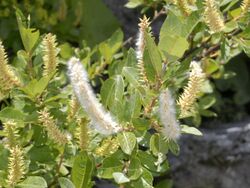Biology:Salix bicolor
| Salix bicolor | |
|---|---|

| |
| Salix bicolor at the Giardino Botanico Alpino Chanousia | |
| Scientific classification | |
| Kingdom: | Plantae |
| Clade: | Tracheophytes |
| Clade: | Angiosperms |
| Clade: | Eudicots |
| Clade: | Rosids |
| Order: | Malpighiales |
| Family: | Salicaceae |
| Genus: | Salix |
| Species: | S. bicolor
|
| Binomial name | |
| Salix bicolor Willd.
| |
| Synonyms | |
| |
Salix bicolor is a species of flowering plant in the family Salicaceae (willows).
Description
Salix bicolor can reach a height of 30–50 centimetres (12–20 in). This plant usually develop into a large shrub, but may grow as a multi branched tree of up to 4 m height. Branches are glabrous. brown-reddish or chestnut. Leaves are yellow-green, glabrous, elliptical or lanceolate with acute apex. They are 5–8 centimetres (2.0–3.1 in) long and 2–3 centimetres (0.79–1.18 in) wide. The catkins are produced in early spring, before the leaves. They reach 3 × 1 cm, on long peduncles with lanceolate bracts. Like all willows this species is dioecious. Flowers bloom from May to June.
Distribution
It is present in mountains of Southern Europe.
Habitat
This species can be found near streams, waterways and moist subalpine pastures at elevation of 1,650–2,350 metres (5,410–7,710 ft) above sea level.
References
Wikidata ☰ Q164645 entry
 |

